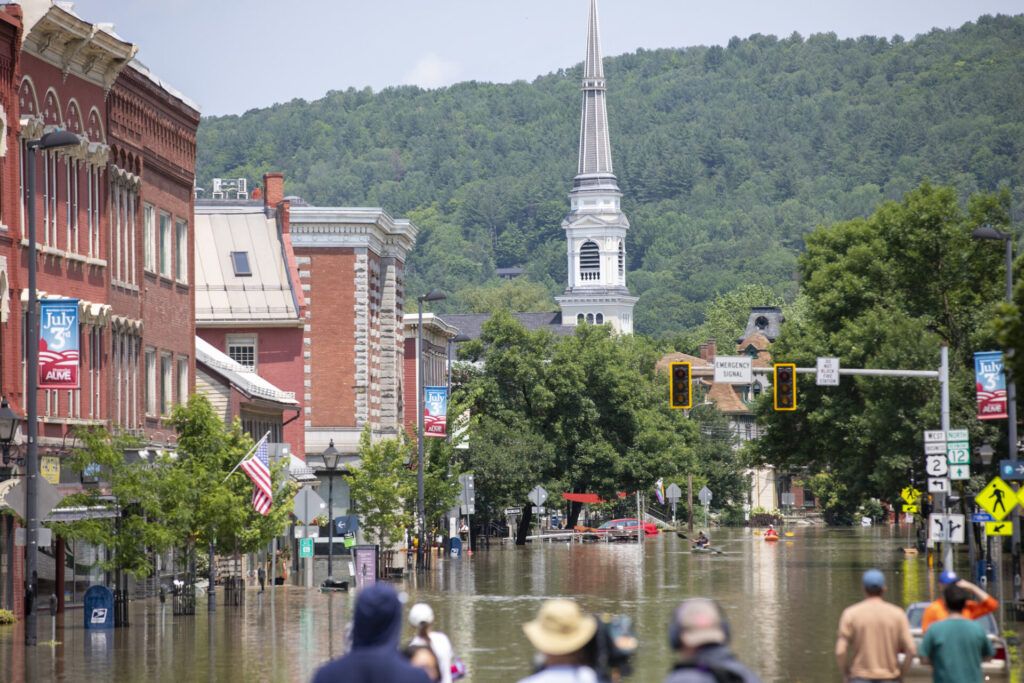From Montana fires to floods in Vermont: Interview with a climate migrant
By Jessica McKenzie | July 14, 2023
 Flooding on main street in Montpelier, Vermont, July 11, 2023. (U.S. Army National Guard photo by Sgt. Denis Nunez)
Flooding on main street in Montpelier, Vermont, July 11, 2023. (U.S. Army National Guard photo by Sgt. Denis Nunez)
This week Vermont (as well as parts of New York and Massachusetts) saw heavy rainfall resulting in catastrophic flooding in the state capital and other low-lying towns across the state. One man drowned in his home; hundreds of others were rescued or evacuated. The full extent of the damage to infrastructure and personal property will not be known for some time, and more rain is forecast for this weekend.
State climate assessments have already found that, because of climate change, Vermont is getting wetter: Precipitation is up 21 percent since the beginning of the 20th century, and the state sees almost two and a half more days of heavy precipitation annually than in the 1960s. Consequently, the state is at an increased risk for damaging rainfall and flooding. And yet Vermont has for several years now been positioning itself as a refuge for people looking to escape the worst ravages of the climate crisis.
“Climate change could be, in some ways, beneficial to Vermont,” Republican Gov. Phil Scott said in 2017. “When we’re seeing some of the activity in California today with wildfires and the lack of water in some regions of the country, if we protect our resources, we could use this as an economic boom in some respects.”
While events this week have underscored the reality that there is no escaping the climate crisis, it is true that people have moved to Vermont because the state is perceived to be safer than other places. Zack Porter, the co-founder of a regional environmental nonprofit called Standing Trees, chose to move with his family from Montana to Montpelier, Vermont, in 2018 to get away from the long wildfire seasons out West. The Bulletin reached out to Porter to ask him about experience as a voluntary climate migrant, and about his hopes and dreams for how Vermont will recover and rebuild from this disaster.
This interview has been condensed and lightly edited.
Jessica McKenzie: What have the past few days been like for you?
Zack Porter: For 24, maybe 36 hours, we were essentially an island, here in the middle of the mountains. There are many roads that are still out, but for the most part, the city is reconnected again.
[After our call, Porter followed up by email to add: “I was volunteering in downtown Montpelier today, helping to clean up the downtown businesses, and the sheer amount of damage really sunk in. There is a second emergency, now, with people who have no access to clean water, no water to even use the bathroom, and no electricity. Farms that were flooded are having to throw out all of their produce and chalk the whole growing season up as a loss.”]
The North Branch of the Winooski River Valley, where we live, just north of the center of Montpelier, was in many ways spared because of an enormous flood control dam that was built in the aftermath of the last major flood event here in Montpelier in 1927. I’m no fan of big dams—healthy, functioning floodplains and wetlands and forests can do an excellent job of mitigating these kinds of flood disasters—but in this case, I’m grateful for the fact that we were able to manage the floodwaters.
McKenzie: I think I saw that for a time there was a possibility that the dam might overflow?
Porter: The dam was never at risk of overtopping. The dam has a spillway, kind of like the little opening in your sink, so that you don’t overfill it. It’s less than ideal to get to a point where this spillway has to be activated, but it’s designed to be a pressure release valve. And so it’s not that the dam is failing, it’s simply that the floodwaters missed that threshold by just one foot. And that would have changed the situation in my area dramatically.
Flooding is probably the most costly and the most frequent disaster that we’ll experience here in the Eastern US, especially up and down the Appalachians. We’ve got these cities that are located in the bottom of river valleys, and all that water wants to go downhill. Montpelier is a great example of a very poorly located city that could really use some major rethinking.
I hope that this event serves as an opportunity to make us question building back exactly as things were, and instead take the opportunity to reimagine a city for the future. There are so many ways to beautify the city and make it more attractive economically to invest in but at the same time also make us more resilient to these kinds of flood disasters.
McKenzie: Why did you move from Montana to Vermont?
Porter: Climate was a huge factor. I think we should be careful not to blame climate change for everything. Because you know, where we located—our city is the problem here in Montpelier. Even though climate change is making things worse, we’ve brought these disasters upon ourselves to a certain degree, too. And the same can be said for many of the problems that we’re facing in the western US, with communities burning that are located inside of the wildland-urban interface. In Missoula, the issue was smoke, largely, and smoke is a natural result of a very natural process. Fires are part of a healthy landscape in the western US, much of it anyways.
What we were experiencing in Missoula was absolutely horrifying: Two months in 2017 of not being able to leave our home. Having a one-year-old child at the time, it was devastating. We were willing to live with the smoke as young adults—childless young adults—but we made the very challenging decision to leave our community, our friends, our adopted family, and our work behind.
We were the privileged ones, though, because we had family here in New England, and opportunities to bring work with us, or start fresh in a new place. We are privileged climate migrants. And I think there’s a real distinction to be made between the people on this planet who are forced out of their homes and people like us who chose to move.
But smoke was the precipitating factor. It’s horrifying to live through. Take the coldest weather there is: You just keep bundling up, and you go out, and you have a good time in the snow. The smoke is something completely different, because there’s no way to escape it. Even indoor air quality becomes unbearable, even with the highest quality air purifiers, and that was just not a future that we wanted to live with.
When we moved to Vermont in 2018, the last thing we expected was for the smoke to follow us across the country. And that’s been heartbreaking, kind of triggering trauma, almost, when we first got it a few years ago, and then had it even worse this year.
McKenzie: Why does land management matter? How does this all tie in to your work at Standing Trees, protecting and restoring native forests?
Porter: A forest is not a forest is not a forest. Just seeing trees doesn’t equal a healthy forest, just seeing an area of wet ground where cattails are growing doesn’t mean that’s a healthy wetland.
We have a huge amount of what some have called ecological amnesia in this country, and really all over the developed world. It’s a part of human nature; we don’t know what we’ve never experienced. We don’t have a reference point for what a healthy forest is, or what a functioning wetland is. And that’s a real problem when we so desperately need fully functioning ecosystems to be our ally in the face of climate change and extinction.
The fact is that if we just think about planting more trees—that’s not good enough, and in fact that’s one of the major areas where the environmental community has really let the American people down.
We have to be thinking about the quality of those forests and those ecosystems. It’s not good enough that Vermont today is by some estimates about 78 percent covered in trees. We’re one of the most forested states in the nation. But what our forests are able to produce for us today—not that they exist for our benefit—but what they produce in terms of water quality benefits and flood mitigation is a fraction of what they could if they were allowed to grow old.
Take carbon storage as an example. Our forests could store two to four times more carbon than they do today, simply by letting them grow old. So many of our forests in the Eastern US were sheep pasture, or agricultural land of other types, just a short time ago. Instead of slowing, spreading, and storing the water that comes in these extreme precipitation events, what you have is still very high amounts of runoff coming out of these relatively young, really simplified forests that don’t actually function in any way how a forest would have here, historically.
We’ve got a great contrast here in the Northeast between the way that we manage our public lands, our state forests and national forests in New England, compared to the way that the state of New York manages its public forests, the Adirondack forest preserve, the Catskill forest preserve, which is to leave them alone. Ten percent of New York state is managed as wild forest, including many of the major headwaters of the Hudson River and of Lake Champlain on the New York side.
Here in Vermont, it’s a completely different story. Just three percent of Vermont and New England’s forests are wild forests. Less than 0.03 percent of our forests are over 150 years old, in the Northeast US and that’s across the Northeast, not just New England. Very few of our forests in New England will ever even be given the chance to grow old.
Logging is the leading cause of tree mortality in the northeast. It’s not extreme weather, it’s not insects, it’s not disease. More trees are cut down by people than are killed by any other force of nature.
McKenzie: Do you talk to your daughter about what’s going on?
Porter: We talk with our daughter openly about everything. She is fully aware—I would say probably more aware than I sometimes wish she was—about how agonizing it was for us to leave our life in Montana, and our community there. And how hard it was to restart, rebuild here. Just this week she’s been talking about it at preschool—the impacts of climate change. Warmer oceans, extreme precipitation. I mean, she’s seven years old, and she was telling us this at the breakfast table.
We took her on a walk downtown to see the flooding so that hopefully she remembers what this was like. I hope that she never has to see this again, but I absolutely wouldn’t bet on it.
I am deeply saddened that this place that we chose to call home, as we retreated from the wildfires, is not a perfectly safe environment for our daughter—as if you could ever find a place like that. But it is really tough to imagine her having to live through something like this again. That’s not the future I want for her.
Together, we make the world safer.
The Bulletin elevates expert voices above the noise. But as an independent nonprofit organization, our operations depend on the support of readers like you. Help us continue to deliver quality journalism that holds leaders accountable. Your support of our work at any level is important. In return, we promise our coverage will be understandable, influential, vigilant, solution-oriented, and fair-minded. Together we can make a difference.
Keywords: climate crisis, climate migration, deforestation, extreme weather, flooding, forests, re-forestation, wildfire smoke
Topics: Climate Change















